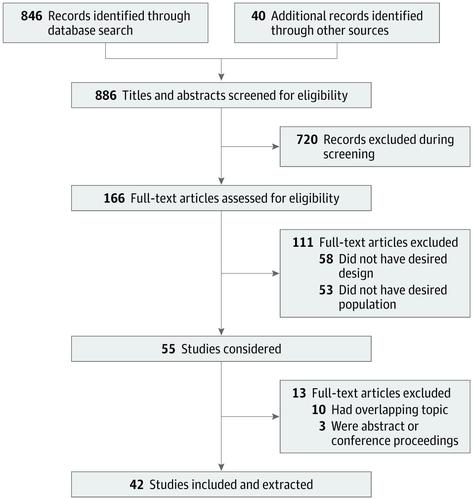JAMA Psychiatry ( IF 22.5 ) Pub Date : 2020-07-01 , DOI: 10.1001/jamapsychiatry.2019.4779 Paolo Fusar-Poli 1, 2, 3, 4 , Gonzalo Salazar de Pablo 1, 5 , Christoph U Correll 6, 7, 8, 9 , Andreas Meyer-Lindenberg 10 , Mark J Millan 11 , Stefan Borgwardt 12, 13 , Silvana Galderisi 14 , Andreas Bechdolf 15, 16, 17, 18 , Andrea Pfennig 19 , Lars Vedel Kessing 20 , Therese van Amelsvoort 21 , Dorien H Nieman 22 , Katharina Domschke 23, 24 , Marie-Odile Krebs 25, 26 , Nikolaos Koutsouleris 27, 28 , Philip McGuire 4, 28 , Kim Q Do 29 , Celso Arango 5

|
Importance Detection, prognosis, and indicated interventions in individuals at clinical high risk for psychosis (CHR-P) are key components of preventive psychiatry.
Objective To provide a comprehensive, evidence-based systematic appraisal of the advancements and limitations of detection, prognosis, and interventions for CHR-P individuals and to formulate updated recommendations.
Evidence Review Web of Science, Cochrane Central Register of Reviews, and Ovid/PsychINFO were searched for articles published from January 1, 2013, to June 30, 2019, to identify meta-analyses conducted in CHR-P individuals. MEDLINE was used to search the reference lists of retrieved articles. Data obtained from each article included first author, year of publication, topic investigated, type of publication, study design and number, sample size of CHR-P population and comparison group, type of comparison group, age and sex of CHR-P individuals, type of prognostic assessment, interventions, quality assessment (using AMSTAR [Assessing the Methodological Quality of Systematic Reviews]), and key findings with their effect sizes.
Findings In total, 42 meta-analyses published in the past 6 years and encompassing 81 outcomes were included. For the detection component, CHR-P individuals were young (mean [SD] age, 20.6 [3.2] years), were more frequently male (58%), and predominantly presented with attenuated psychotic symptoms lasting for more than 1 year before their presentation at specialized services. CHR-P individuals accumulated several sociodemographic risk factors compared with control participants. Substance use (33% tobacco use and 27% cannabis use), comorbid mental disorders (41% with depressive disorders and 15% with anxiety disorders), suicidal ideation (66%), and self-harm (49%) were also frequently seen in CHR-P individuals. CHR-P individuals showed impairments in work (Cohen d = 0.57) or educational functioning (Cohen d = 0.21), social functioning (Cohen d = 1.25), and quality of life (Cohen d = 1.75). Several neurobiological and neurocognitive alterations were confirmed in this study. For the prognosis component, the prognostic accuracy of CHR-P instruments was good, provided they were used in clinical samples. Overall, risk of psychosis was 22% at 3 years, and the risk was the highest in the brief and limited intermittent psychotic symptoms subgroup (38%). Baseline severity of attenuated psychotic (Cohen d = 0.35) and negative symptoms (Cohen d = 0.39) as well as low functioning (Cohen d = 0.29) were associated with an increased risk of psychosis. Controlling risk enrichment and implementing sequential risk assessments can optimize prognostic accuracy. For the intervention component, no robust evidence yet exists to favor any indicated intervention over another (including needs-based interventions and control conditions) for preventing psychosis or ameliorating any other outcome in CHR-P individuals. However, because the uncertainty of this evidence is high, needs-based and psychological interventions should still be offered.
Conclusions and Relevance This review confirmed recent substantial advancements in the detection and prognosis of CHR-P individuals while suggesting that effective indicated interventions need to be identified. This evidence suggests a need for specialized services to detect CHR-P individuals in primary and secondary care settings, to formulate a prognosis with validated psychometric instruments, and to offer needs-based and psychological interventions.
中文翻译:

预防精神病:检测,预后和干预方面的进展。
在临床上有精神病高风险(CHR-P)的个体中的重要性检测,预后和明确的干预措施是预防性精神病学的关键组成部分。
目的 对CHR-P个体的检测,预后和干预的进展和局限性进行全面,循证的系统评估,并提出更新的建议。
搜索了《科学证据审查网》,Cochrane中央评论注册处和Ovid / PsychINFO,检索了2013年1月1日至2019年6月30日发表的文章,以鉴定在CHR-P个体中进行的荟萃分析。MEDLINE用于搜索检索到的文章的参考列表。从每篇文章获得的数据包括第一作者,出版年份,研究主题,出版物类型,研究设计和数量,CHR-P人群和对照组的样本量,对照组的类型,CHR-P个体的年龄和性别,预后评估的类型,干预措施,质量评估(使用AMSTAR [评估系统评价的方法学质量])以及关键发现及其影响大小。
结果 总共包括了过去6年发表的42项荟萃分析,涵盖81项结果。对于检测成分,CHR-P个体年龄较小(平均[SD]年龄,为20.6 [3.2]岁),男性更常见(58%),并且主要表现为精神病症状减轻,持续时间超过1年。在专业服务。与对照组相比,CHR-P患者积累了一些社会人口统计学危险因素。还经常看到物质使用(33%的烟草使用和27%的大麻使用),合并症,精神疾病(抑郁症占41%,焦虑症占15%),自杀意念(66%)和自残(49%)在CHR-P个人中。CHR-P个人表现出工作障碍(Cohen d = 0.57)或教育功能(Cohen d = 0.21),社会功能(Cohen d = 1.25)和生活质量(Cohen d = 1.75)。这项研究证实了几种神经生物学和神经认知的改变。对于预后成分,如果将CHR-P仪器用于临床样本,则其预后准确性良好。总体而言,3年时精神病的风险为22%,在短暂和有限的间歇性精神病症状亚组中,该风险最高(38%)。轻度精神病(Cohen d = 0.35)和阴性症状(Cohen d = 0.39)以及低功能(Cohen d = 0.29)与精神病风险增加相关。控制风险丰富和实施顺序风险评估可以优化预后准确性。对于干预措施的组成部分,尚无确凿的证据来支持任何指示性干预措施(包括基于需求的干预措施和控制条件),以预防CHR-P个体中的精神病或改善任何其他结局。但是,由于该证据的不确定性很高,因此仍应提供基于需求的心理干预。
结论与相关性 该评价证实了在CHR-P个体的检测和预后方面的最新进展,同时提示需要确定有效的指示干预措施。该证据表明需要专门服务来检测初级和二级保健机构中的CHR-P个体,用经过验证的心理测量仪器来制定预后,并提供基于需求的心理干预。











































 京公网安备 11010802027423号
京公网安备 11010802027423号